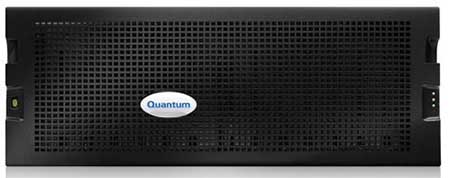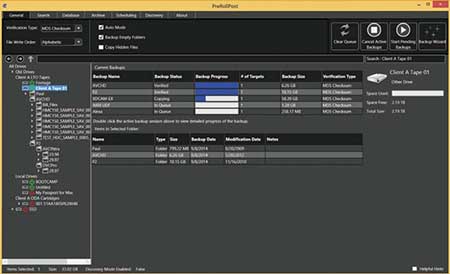Archiving in Today’s Digital Haystack
SAN FRANCISCO—There’s more than one change happening in the archiving space. New solutions that tightly weave together asset management and storage are on the rise, as are archiving modules that scout and scour content for truly useful metadata details, even down to delivery orders and companion documents. Add to that the fact that broadcasters have begun to more seriously investigate the cloud’s usefulness for short- and long-term storage.

At the NAB Show, Tedial will introduce a new search engine for its Evolution media IT platform that indexes very large databases and automatically tags descriptive metadata. “The whole purpose for archiving these days is that there is a massive and increasing amount of content that has to be stored,” said Lee Sheppard, director of product management for SGL, a Whiteley, England-based provider of media archiving systems.
The challenge, he said, becomes two-fold: finding adequate archiving space for all these new, enormous 4K and HD files, while also being able to find that one specific meaningful clip within the digital haystack.
What do you store online? What do you relegate to nearline disk storage? Where do you go from there?
INTELLIGENT MANAGEMENT

In its NAB Show booth, Quantum will demo its new Q-Cloud hybrid cloud storage system working within the company’s StorNext storage platform. There are a number of companies that are putting faith in the cloud. Imagine Communications, for one, has jumped into the cloud space with a number of solutions, including VersioCloud, an IP-enabled software playout-in-the-cloud platform that offers traditional channel playout functions including automation, branding, graphics and file server capabilities.
Quantum is also investing in the cloud. The San Jose, Calif.-based storage specialist has introduced three new solutions that integrate the cloud into hybrid storage architectures for high-density storage options and will be demonstrated at its NAB Show booth. Known as Q-Cloud, these hybrid solutions use data management software for storage in the cloud. The Q-Cloud Archive and Q-Cloud Vault use the cloud as an off-site tier within a Quantum StorNext 5 workflow environment, while Q-Cloud Protect enables customers to use de-duplication appliances to replicate data to the Amazon Web Services cloud, which allows users to use cloud offerings without replacing existing applications.
The professional video industry's #1 source for news, trends and product and tech information. Sign up below.
“We designed our new Q-Cloud solutions to be deployed in broader, intelligently managed hybrid architectures that enable customers to optimize the use of both on-premise and cloud storage in the most efficient and cost-effective way possible,” said Geoff Stedman, senior vice president of StorNext Solutions for Quantum.
SGL, too, is investing in new cloud-based archiving capabilities with an asset management spin. The company’s FlashNet content management solution includes cloud-based archiving capabilities, a move that takes into account the myriad ways that broadcasters need to store and access their content.
With complex broadcast environments, Sheppard said, there’s a decision to be made on whether to keep content on a local disk, put it away on deep storage tape or place it on the cloud. “But you still need to be able to manage where all of those assets are,” he said. “The archiving management system controls how to manage and track where they all are, whether it’s on tape or on the cloud.”
DIVING INTO METADATA
Teaming together asset management technology and archiving was also a priority for Tedial, which introduced an enhanced version of the company’s media IT platform, Tedial Evolution. The system is designed to extend MAM functionality with new search and indexing tools and provide improved integration between archive and workflow engines. At its NAB Show booth, the company plans to introduce a new search engine for indexing very large databases and automatically tag descriptive metadata. An expanded solution, called Tarsys Mediaset, delves deeply into all the information surrounding an asset—including metadata, media files, attached documents and delivery orders.

At the NAB Show, Imagine Products is introducing PreRoll Post, which can be used with Sony’s optical disc archive to automate the indexing of camera originals. Imagine Communications has also worked to weave storage into its digital asset management technology by partnering with Front Porch Digital, which was acquired by Oracle in 2014. The two companies are working together to include Front Porch Digital’s DIVArchive CSM system within Imagine’s digital asset management portfolio. The move enables Imagine to expand its offering of advanced storage capabilities and archiving.
Another company that is bundling asset management solutions with storage is TMD, which adopted an open standards-based approach to long-term storage by adding direct LTFS support to its Mediaflex asset management system, thereby reducing the cost of data tape archiving for deep storage. The system also allows for partial restores, tape externalization and compatibility with other LTFS archives. At its NAB Show booth, the company will also showcase a new browser-based user interface, called Chameleon.
Imagine Products of Indianapolis has been active in the linear tape file system arena, introducing a system called PreRoll Post that will be used with Sony’s optical-disc archive to automate the indexing of camera originals. Proxies and metadata can be searched and indexed, and users have the option to back up full-resolution media to local disk and long-term LTO tapes as well as optical-disc storage or a traditional server.
Migrating those assets is a priority for companies like SGL, which is introducing a new version of the FlashNet Migration Service. A broadcaster with 1,000 tapes who is ready to use more high high-density storage can use the system to copy all the content on each of these tapes onto the new high-density storage, at a faster speed, according to SGL’s Sheppard.
“When they are ready to migrate to the next generation, they can run it in the background, in half the time it would normally take,” he said. “We are introducing this new system and partial file restore, something that becomes a big deal with more sophisticated archive management systems. If you’ve got a piece of content that’s a terabyte in size, it will take a long time to restore, particularly if you’ve only got two minutes [that you want to pull out]. And so the partial file restore allows you to do that [more effectively].”
For those networks with super high storage requirements, Quantum recently introduced the StorNext QXS-5600 high-capacity and high-density disk array, designed for customers managing large files containing high-resolution video or images, including 4K and 8K video production and post images. The product provides up to 336 TB of raw capacity in 4RU.
It isn’t just traditional broadcasters who are in on the newest options in the archiving game. Unique storage solutions are being used by non-traditional broadcast organizations like the military and houses of worship. SpectraLogic’s Spectra T680 tape library was used earlier this year by the Christian organization Joyce Meyer Ministries, which broadcasts radio and TV programs online. The organization produces more than 300 episodes annually and built a post-production workflow that allowed for restoration of offline footage and legacy broadcasts for repurposing into new programs. The Spectra T680 with LTO- 6 drives is being used to manage more than 500 TB of expanding video files alongside a Spectra nTier Verde disk-based file storage system.
Susan Ashworth is the former editor of TV Technology. In addition to her work covering the broadcast television industry, she has served as editor of two housing finance magazines and written about topics as varied as education, radio, chess, music and sports. Outside of her life as a writer, she recently served as president of a local nonprofit organization supporting girls in baseball.

